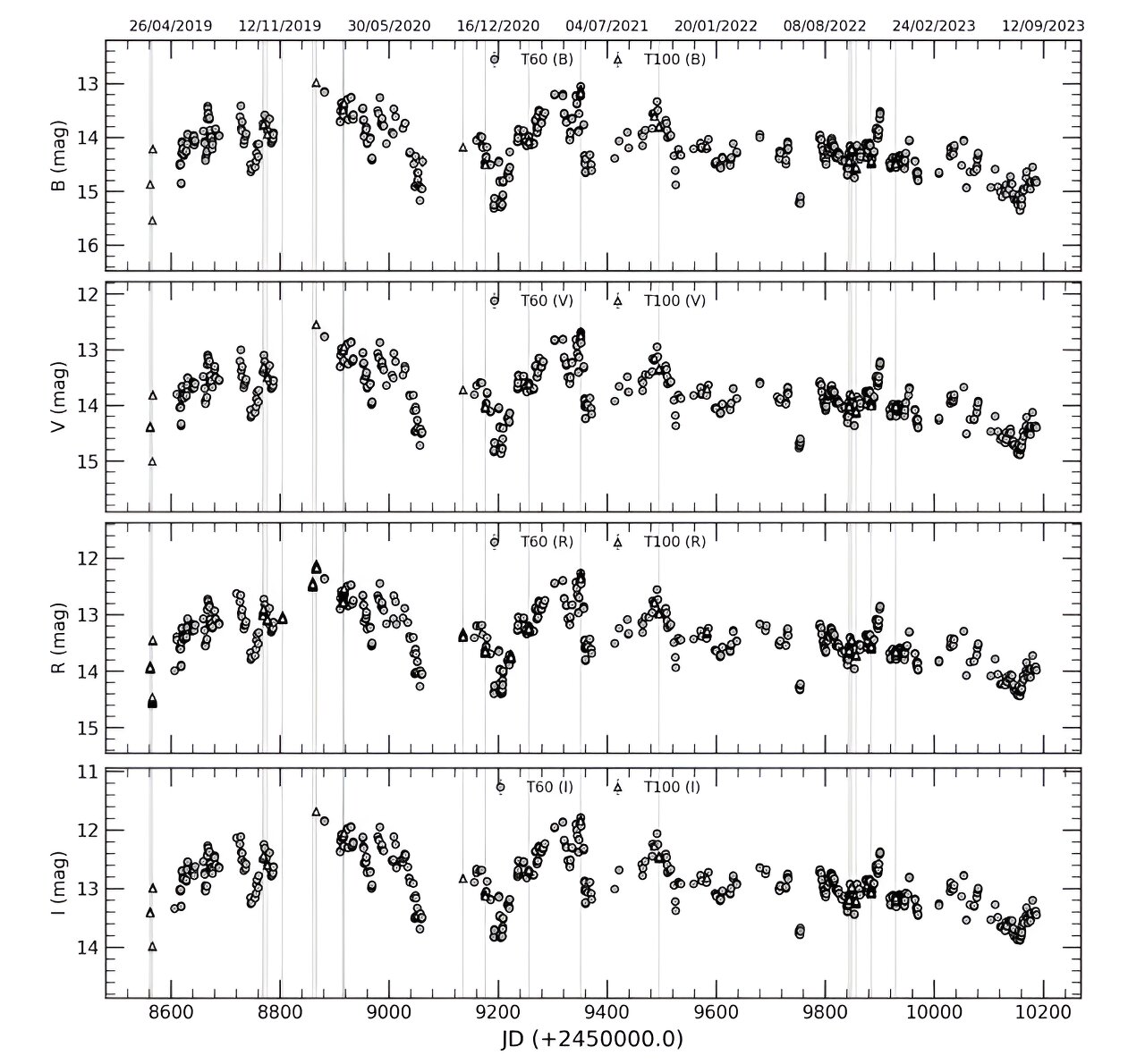
Long-term light curves of the blazar S5 0716+714 in the optical bands B, V, R and I. Credit: Ege et al., 2024.
Using the TÜBİTAK National Observatory, astronomers from Turkey and India have observed a bright blazar known as S5 0716+714. The results of the observation campaign, published on July 12 on the pre-print server arXivprovide essential information about the optical variability of this blazar.
Blazars are very compact quasars associated with supermassive black holes (SMBHs) at the centers of active giant elliptical galaxies. They belong to a larger group of active galaxies that host active galactic nuclei (AGN) and are the most abundant extragalactic sources of gamma rays. Their characteristic features are relativistic jets directed almost exactly towards the Earth.
Based on their optical emission properties, astronomers divide blazars into two classes: flat-spectrum radio quasars (FSRQs) that exhibit prominent and broad optical emission lines, and BL Lacertae objects (BL Lacs), which do not they do.
S5 0716+714 is a blazar with a redshift of 0.23, first discovered in 1979 as part of a survey of extragalactic radio sources. It is one of the brightest and most active BL Lacs discovered so far.
S5 0716+714 shows extreme optical variability, and because of this, has been the subject of several optical monitoring campaigns. The latest of these was carried out by a group of astronomers led by Ergün Ege of Istanbul University. For this purpose, they used the T60 and T100 telescopes of the TÜBİTAK National Observatory.
“We present the results of the observational study of the blazar S5 0716+714 in the B, V, R and I optical bands between March 2019 and August 2023 to investigate its variability on different time scales,” the researchers write.
The observations revealed that the luminosity of S5 0716+714 varied between 12.11 and 14.58 in the optical R band. Furthermore, the long-term light curve shows that the blazar had a variability amplitude of approximately 256.12, 247.08, 247.04, 230.21 percent in the B, V, R, I, respectively.
When it comes to intraday variability (IDV), the results show that S5 0716+714 was significantly variable in the R band on 12 out of 21 observation nights. On those days, the blazar had a significant IDV with a magnitude variation of approximately 0.1 mag and a variability amplitude between 4.41 and 11.23 in the BVRI bands.
The study found that S5 0716+714 likely has quasi-periods of about 186 and 532 days in its R-band light curve. Astronomers hypothesize that the 186-day quasi-periodic oscillation (QPO) indicates two blazar explosions that may have happened in May and October 2021.
Based on the collected data, the authors of the paper were also able to calculate that the size of the emission region in S5 0716+714 is about 67 AU and that the mass of the SMBH of the blazar is at the level of 569 million solar masses.
More information:
Ergün Ege et al, Investigation of the optical variability of the blazar S5 0716+714 on different time scales, arXiv (2024). DOI: 10.48550/arxiv.2407.09419
Magazine Information:
arXiv
© 2024 Science X Network
citation: Study probes optical variability of blazar S5 0716+714 (2024 July 22) Retrieved July 22, 2024 from https://phys.org/news/2024-07-optical-variability-blazar-s5.html
This document is subject to copyright. Except for any fair agreement for study or private research purposes, no part may be reproduced without written permission. The content is provided for informational purposes only.
